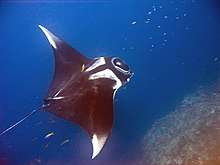Mobulidae
The Mobulidae (manta rays and devilfishes) are a family of rays consisting mostly of large species living in the open ocean rather than on the sea bottom.
| Mobulidae | |
|---|---|
 | |
| Mobula birostris at Hin Daeng, Thailand | |
| Scientific classification | |
| Kingdom: | Animalia |
| Phylum: | Chordata |
| Class: | Chondrichthyes |
| Order: | Myliobatiformes |
| Family: | Mobulidae Gill, 1893[1] |
| Genera | |
Taxonomy
The Mobulidae have been variously considered a subfamily of the Myliobatidae by some authors,[2][3] and a distinct family by others, but recent work favors the latter.[4] Two genera have been traditionally recognized, Manta and Mobula, but recent DNA analysis shows that Mobula as traditionally recognized is paraphyletic to manta rays, making Manta a junior synonym of Mobula.[5]
Fossil record
Several genera of fossil mobulids are known, including Archaeomanta, Burnhamia, Eomobula, and Paramobula.[6][7][8]
gollark: ARing.
gollark: Razorcrests?
gollark: Maybe we'll learn one day that the trick to NDs is just to use, I don't know, the blue "ravenclaw" ones which are so generic I can't remember the name.
gollark: Probably.
gollark: I'm going to try and hatch the stupid thing.
References
- Gill, Theodore (1893). "Families and Subfamilies of Fishes". Memoirs of the National Academy of Sciences. 6 (6): 130.
- Nelson, Joseph S. (2006). "Subfamily Mobulinae (devil rays)". Fishes of the World (4th ed.). Hoboken: Wiley. p. 82.
- Nelson, Joseph S.; Grande, Terry C.; Wilson, Mark V. H. (2016). "Subfamily Mobulinae (devil rays)". Fishes of the World (5th ed.). Hoboken: Wiley. pp. 94–95. doi:10.1002/9781119174844.ch2.
- White, W. T.; Last, P. R. (2016). "Devilrays: Family Mobulidae". In Last, Peter R.; White, William T.; de Carvalho, Marceo R.; Séret, Bernard; Stehmann, Matthias F. W.; Naylor, Gavin J. P. (eds.). Rays of the World. Ithaca: Cornell University Press. pp. 741–749. ISBN 9781501705328.
- White, William T.; Corrigan, Shannon; Yang, Lei; Henderson, Aaron C.; Bazinet, Adam L.; Swofford, David L.; Naylor, Gavin J. P. (2017). "Phylogeny of the manta and devilrays (Chondrichthyes: mobulidae), with an updated taxonomic arrangement for the family". Zoological Journal of the Linnean Society. zlx018. doi:10.1093/zoolinnean/zlx018.
- Cappetta, H. (1987). Chondrichthyes II Mesozoic and Cenozoic Elasmobranchii. Handbook of Paleoichthyology. 3B. Stuttgart: Gustav Fischer Verlag.
- Herman, J.; Hovestadt-Euller, M.; Hovestadt, D. C. (1989). "Additions to the Eocene fish fauna of Belgium. 9. Discovery of Eomobula gen. et. sp. nov. (Mobulidae, Chondrichthyes) from the Ypresian" (PDF). Tertiary Research. Leiden. 10 (4): 175–178.
- Cicimurri, David J.; Knight, James L. (2009). "Late Oligocene Sharks and Rays from the Chandler Bridge Formation, Dorchester County, South Carolina, USA". Acta Palaeontologica Polonica. 54 (4): 627–647. doi:10.4202/app.2008.0077.
This article is issued from Wikipedia. The text is licensed under Creative Commons - Attribution - Sharealike. Additional terms may apply for the media files.